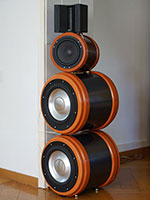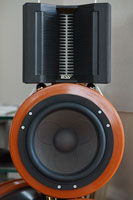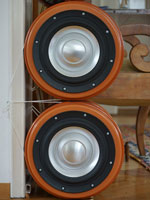3-way Loudspeaker System With Dipole Tweeters
After a
previous build
based on vertically stacked planar magnetic speakers,
I decided to make a more or less conventional multiway loudspeaker system,
keeping the dipole radiation for the highs only.
It has evolved into a linear-phase computer controlled system. Please follow
this link to see how.
I used John Mulcahy's (many thanks) REW analysis software and Phonic PAA3 31-band real time spectrum analyzer.
Tweeter
The dipole tweeters are ESS Great Heil AMT. They are 'great' in every respect: response, dispersion, harmonic distortion. They have a high sensitivity and can be crossed-over remarkably low. For best integration, special attention should be given to two attributes:
The dipole roll off below the peak at 5 kHz is 3dB per octave. This can be easily equalized.


The graph (measure at 20 cm) doesn't show a first peak at 340 Hz that can be neglected in this context.
There is an additional phase shift. This can be exploited at the crossover (see below).

Midwoofer
The excellent
Scanspeak
Illuminator 18WU/4741T00
is used for bass/midrange.
Six liter sealed enclosures are made of PVC pipes filled with a polyester fleece.
The build is simple: just a connecting sleeve with rubber rings and two plugs (no glue).
Internal standing waves start at 800 Hz. Calculated Qtc=1.08 and F3=74 Hz.
Measured at 15 cm, it's equalized flat as shown in the next figure.
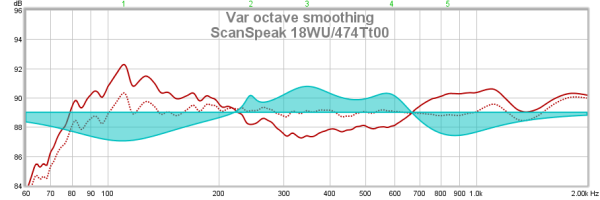
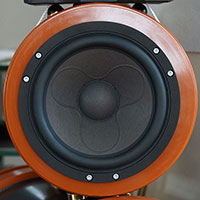
Subwoofer
The bass extension is provided by two
SB Acoustics
10” SW26DAC76-4
per channel.
With dual rigid aluminum cone and moderate moving mass,
this lightweight (neodymium magnet) driver can be used in a rather small sealed enclosure.
Like the midwoofers, the 21 liters enclosures were very easy to build: PVC connecting sleeve with rubber rings, polyester fleece and two plugs.
Internal standing waves start at 570 Hz. Calculated Qtc=0.86 and F3=35 Hz.
Equalization flattens the frequency response and extends it down to 24 Hz.
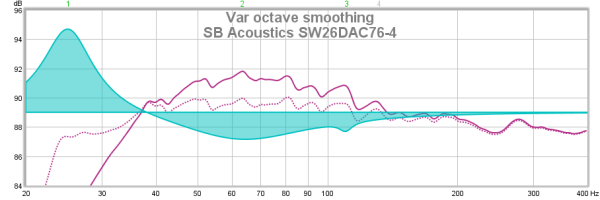
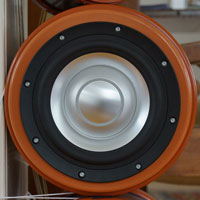
Operating
Power is supplied by two
Rotel
RMB-1565
5 channels Class D amplifiers, one for each stereo channel.
Loudspeaker filtering and equalization are done in the digital domain by a
miniDSP
10x10 Hd with the
4x10 Xover plug-in.
The 24-bit / 96 kHz digital signal is provided by a computer (all my music is dematerialised) through a
S/PDIF Bridge from
Halide Design.
Integrating three drivers to form an ensemble is a sensitive task, especially when they are made of different materials and technologies. I follow two principles: each driver must sound good when played alone in its specific range and small differences in the setting can have significant audible effects. It's all about finding appropriate crossover frequencies and slopes. Fortunately, digital filters are flexible and fast to operate.
Subwoofers should reproduce frequencies under 100 Hz but not much above. I chose a 6th order Butterworth filter against the slower roll-off of Linkwitz-Riley. Listening to the subs alone, best results were obtained with a cutoff at 97 Hz. Deep bass is not altered by the steep filter and the human voice is not present. The cutoff for the midwoofer is set one eighth of octave higher at 106 Hz to obtain a flatter response.
For the mid-highs, I like third order crossovers but their phase quadrature, hence asymetric polar response.
I mentioned above the phase shift of the AMT tweeter.
If it adds 90° to the crossover quadrature, we're 180° out of phase.
This is the case around 1139 Hz (double of AMT low resonance), as revealed by the -10 dB depression shown in the next figure.
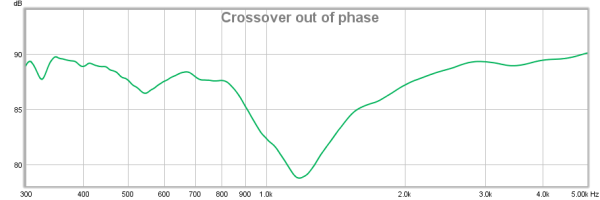
Reverse the polarity of one driver and the phase is tracked, that's it.
Moreover, at this cutoff, the midwoofer listened alone covers the fundamentals of the human voice but doesn't beam in the highs.
In brief, the crossover frequencies are 101 Hz (6th order Butterworth, offset 1.1) and 1139 Hz (third order Butterworth).
Polarity of the midwoofer is reversed.
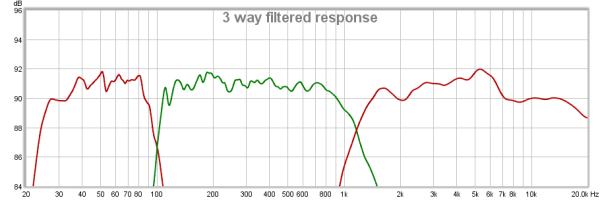
The next figure shows the real time spectrum analysis on pink noise at the listening position, 3.5m away from the speakers, filters applied, average of eight measures.

Listening
This one fulfills my expectations, not just for specific strengths.
Whatever the loudness, the soundstage is natural, it has a broad sweet spot with a warm balance, yet ultra-clear tone quality.
Nothing's exhausting, no stridencies, no compression, no blur.
It's also noticeable that the double subs are rather immune to room modes.
Distinct and full-bodied voices, delicious strings, throaty saxophone, hard guitar,
techno bass, dry or heavy drums, everything is played equally effortless.
Lesser quality recordings remain what they are, of course, but don't become overly bad.
For me, nothing is missing

June 2015
 JdM12
JdM12
